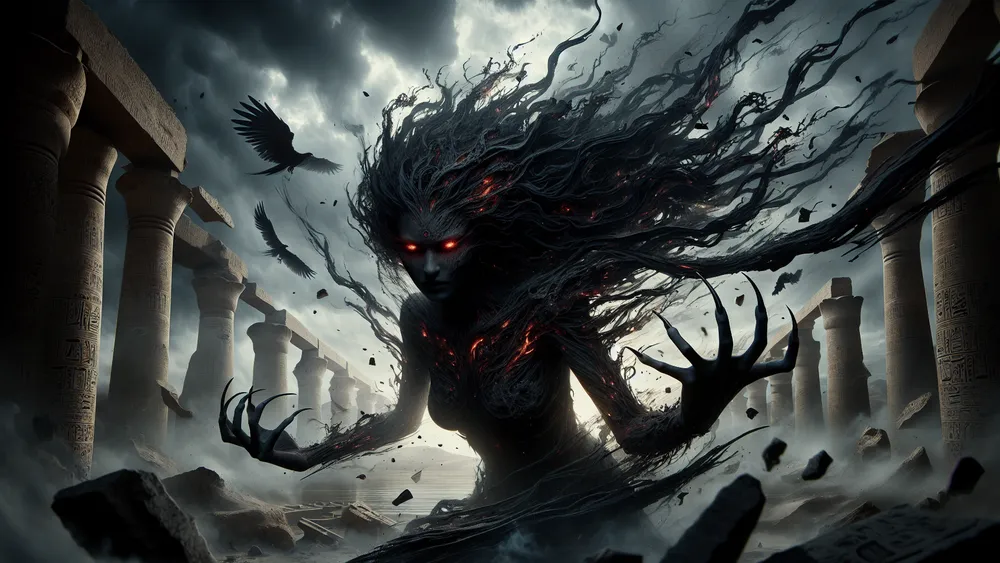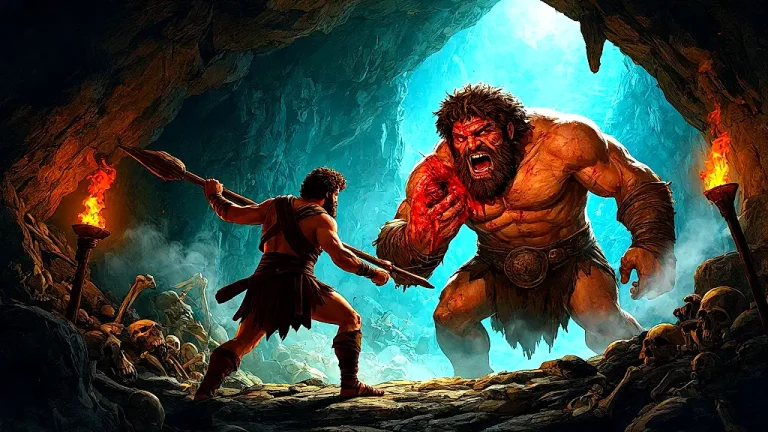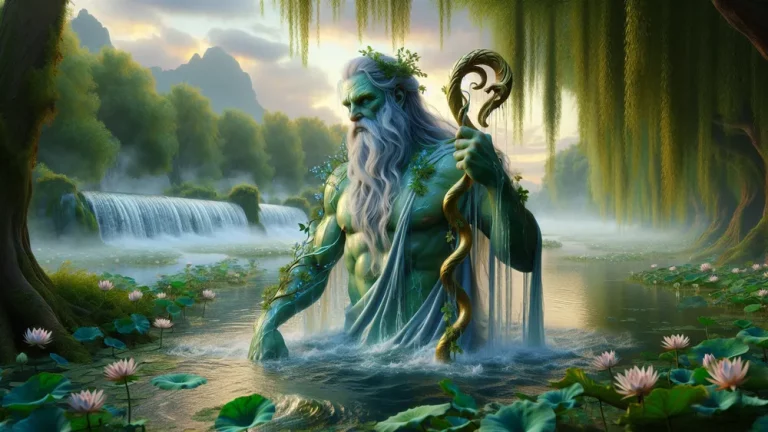Isfet: Ancient Egyptian Concept of Chaos and Disorder
Within the thick fabric of Egyptian stories and beliefs, the idea of Isfet stands out as something big that shows mess and disorder. Picture a world where every little thing is carefully kept balanced, similar to a well-played band; now, see a sudden, upsetting mess – a storm that makes everything mixed up.
Key Points:
- Isfet in Egyptian mythology represents chaos and disorder, contrasting with Maat, which symbolizes order and calm.
- Isfet is symbolized as a snake or a force of cosmic imbalance in Egyptian stories.
- Ancient Egyptians viewed Isfet and Maat as essential opposing forces that needed to be balanced for the world to function properly.
- Rituals and ceremonies were performed by ancient Egyptians to keep Isfet at bay and maintain order.
- Isfet played a crucial role in Egyptian creation stories as the initial chaos before order was established.
- Isfet’s impact on ancient Egyptian society influenced their values and daily rituals, emphasizing the importance of maintaining order and peace.
- In modern times, Isfet is often seen as a symbol of chaos and disorder in popular culture, reflecting its ancient significance.
That’s what Isfet means. In this post, we will look into the view and importance of Isfet, checking out its part in starting tales, its signs in stories and legends, and its big effects on old Egyptian life. We will also look at how the old Egyptians tried to keep things balanced by special acts and steps made to fight Isfet, and how this idea has changed in recent views.
By the end of this trip, you will know a lot about Isfet and its key role in the old Egyptian world and stories.
Isfet: Overview and Key Facts
| Key Point | Description |
|---|---|
| Definition | Isfet is about chaos, mess, and breaking things apart in Egyptian myths. It is the opposite of Maat, which means order and calm. |
| Symbolism | Isfet often shows up as a snake or a force of disorder, showing cosmic imbalance. |
| Role in Mythology | Isfet is important in stories of making the world, showing the first mess before order was made. |
| Duality with Maat | Ancient Egyptians thought Isfet and Maat were like two halves of the same thing, with their balance needed for the world to stay steady. |
| Impact on Society | The idea of Isfet shaped how old Egyptians thought about right and wrong, showing why keeping order was key to fight against mess. |
| Rituals and Practices | To keep Isfet away, various actions like offerings, special words, and ceremonies for gods related to order were done. |
| Modern Interpretations | These days, Isfet is often seen in books and shows as a sign of mess and the fight to keep balance. |
Getting to Know Isfet in Egyptian Mythology
To really grasp Isfet’s part and how important it is in Egyptian myths, we need to look more into its traits and the relationship it has with Maat.
What Is Isfet?: Chaos, Disorder, and the Unmaking of Things
Isfet, in Egyptian stories, is the show of chaos, disorder, and breaking things apart. Think of a room that’s very tidy suddenly messed up by a big storm; this shows the upsetting power of Isfet. It means the opposite of Maat, which stands for order, calm, and the fixed world. The importance of Isfet is in how it is put against Maat, showing how ancient Egyptians believed in needing balance in everything. To get a better idea of Isfet, here are some key thoughts:
- Chaos: Isfet messes up the natural way, making things unclear and confusing.
- Disorder: It shows the breaking down of social and world rules.
- Uncreation: Isfet shows the idea of going back to an old state of nothing, undoing the making of things.
By knowing Isfet, we see how ancient Egyptians thought about the ongoing fight between chaos and order, needed for the world’s steadiness.
Ancient Egyptians valued balance between chaos (Isfet) and order (Maat) to maintain stability in the world.
How Isfet and Maat Are Two Sides of the Same Coin
In Egyptian stories, Isfet and Maat show a basic pair, meaning chaos and order. The old Egyptians saw these forces as relying on each other, like night and day or how tides move in and out. Isfet, with its messy and breaking nature, was seen as needed against Maat, which meant calm, balance, and fairness.

This pair was not just an idea but a way to see the world. They believed that the world’s steadiness needed a careful balance between these opposite forces. Without Isfet, Maat’s order would have no meaning, and without Maat, Isfet’s chaos would be unchecked.
To show this pair, think of the story of Ra, the sun god, fighting the snake Apophis (a sign of Isfet) each night to make sure the sun comes up each morning.
This daily fight shows the ongoing fight and balance between chaos and order. Another story is of Osiris and Set, where Set (seen with Isfet) upsets the order by killing Osiris, but later, Horus (seen with Maat) sets balance back by avenging his father.
These stories show the belief that the balance between Isfet and Maat was needed for the world to work right. The old Egyptians’ actions and social rules were deeply shaped by this need to keep Maat and stop Isfet, showing how they saw the world’s natural pair.
Isfet’s Role in Creation Stories
In Egyptian creation stories, Isfet has a critical part as the first chaos that was there before the world was organized. Think of the universe as an empty space, where the first touches are wild and messy, starting things off.

This messy state, shown by Isfet, was seen as needed before the coming of order and balance, shown by Maat. The Egyptians thought that making the world was about putting order on chaos. In the Heliopolitan creation story, the god Atum comes from the chaotic waters of Nun (a sign of Isfet) to make the world.
This story shows the idea that without the first chaos of Isfet, the organized and balanced world ruled by Maat could not be. Therefore, Isfet’s presence in these stories shows its key part in the world’s cycle of making and order.
Stories and Legends About Isfet
To understand Isfet’s importance, look into the stories that show this force of chaos and disorder.
Where Isfet Came From and Its Legendary Stories
Isfet comes from old Egyptian thoughts about the universe’s natural two sides. It is not a god but shows the chaotic and breaking forces against Maat, which is order and calm. Isfet’s start can be seen in the first chaos before the world was made.
In the Heliopolitan creation story, the god Atum comes out of the chaotic waters of Nun, which stand for Isfet, to begin creation. This story shows that Isfet is always there and needs to be fought to keep balance in the universe. Some main stories show Isfet’s dealings with other gods, showing its part in the world’s order.
One well-known story is the nightly fight between Ra, the sun god, and Apophis, a snake showing Isfet. Every night, Apophis tries to eat Ra, showing the ongoing danger of chaos winning over order. Another big story tells about Set, the god of chaos and disorder, who is linked with Isfet.
Set kills Osiris, messing up the natural order, but then Horus, who gets back at his father, brings back the balance. These stories point out the ongoing fight between Isfet and forces of order, showing the old Egyptians’ belief in the need for careful watching and rituals to keep chaos away.
The Big Myths Featuring Isfet
Some main myths in Egyptian stories show Isfet, showing its part as chaos and disorder. An important story is the nightly fight between Ra, the sun god, and Apophis, a snake that stands for Isfet. Every night, Apophis tries to eat Ra, showing the always-there danger of chaos winning over order.
Another big story is about Set, the god of chaos, who has ties with Isfet. Set kills Osiris, which messes up the natural order, but then Horus, who gets back at his dad, brings back balance. These stories show the ongoing fight between order and chaos, showing the need for watching and rituals to keep harmony.
The meaning of these myths is in how they show Isfet’s role in Egyptian stories. Isfet is not just a destroyer but a needed part next to Maat, which is the idea of order. The myths show that chaos and order need each other, like night and day.

For example, the nightly fight between Ra and Apophis can be seen as the daily cycle, where dark (chaos) must go away for light (order). The story of Set and Osiris also shows that messing up and fixing things are part of the natural flow. These myths remind people how important it is to keep balance and order in the universe and in human life.
- Ra and Apophis: Nightly fight showing the battle between chaos and order.
- Set and Osiris: Set kills Osiris, and Horus works to bring back balance.
- Nun and Atum: Atum comes from the chaotic waters of Nun to make the world.
What Isfet Symbolized in Egyptian Tales
In Egyptian stories, Isfet stood for chaos and disorder using different symbols. One big symbol was the serpent Apophis, which showed the dangerous forces that threatened the cosmic order. In pictures, Apophis was a large snake subdued by gods, which showed the ongoing fight against chaos.
Also, the chaotic waters of Nun, from which the god Atum came out to make the world, showed the first state of disorder that Isfet stood for. These symbols were not only in mythology but also showed up in religious acts and writings. For example, during religious events, priests would say spells and perform actions to fight Isfet’s impact, often using the image of subduing snakes or calming wild waters.
These symbols were powerful reminders of the always-there danger of chaos and the need to keep balance and order in the universe and daily life.

Isfet represented chaos and disorder in Egyptian stories through symbols like the serpent Apophis, emphasizing the constant battle against chaos in maintaining cosmic order.
How Isfet Affected Ancient Egyptian Life
To know Isfet and what it stood for and its stories makes clear its deep impact on old Egyptian society. How did Isfet change their values, their rituals, and their daily life? Let’s find out.
How Isfet Shaped Egyptian Values
The idea of Isfet had a big impact on old Egyptian behavior and way of thinking by showing how important order and peace were in society. They thought Isfet – which means chaos and disorder – was always a threat. So, to fight it, they had to keep Maat, which is about truth, balance, and fairness. This belief touched their daily lives, making people act right and keep social peace.

For example, just like we might follow rules to avoid chaos, they followed moral rules and social laws to stop Isfet. The need to keep order and peace was clear in their laws, religious actions, and personal behavior, all trying to make sure chaos didn’t mess up their world.
Rituals and Practices to Keep Isfet at Bay
To push back Isfet and keep things in order, old Egyptians did many rituals and things. Built into their religion and daily life, these actions called on gods to help keep Maat steady. For example, every day in temples, priests did rituals, saying special words and songs to block chaos.

They offered gifts to gods, broke clay dolls as symbols of enemies, and used items to protect themselves. Just like how we use locks to keep our homes safe, these rituals worked as spiritual guards against Isfet.
Here is a list that explains some key rituals, their goals, and which gods were part of them:
| Ritual | Goal | Gods Involved |
|---|---|---|
| Daily Temple Actions | Keep things in order and get godly help | Ra, Amon, Osiris |
| Breaking Clay Dolls | Break enemies and chaos symbolically | Set, Horus |
| Saying Protective Words | Drive away bad things and chaos | Thoth, Isis |
| Offering Gifts | Make gods happy and get their support | Many gods |
| Using Protective Items | Get personal safety from Isfet | Bes, Taweret |
These actions were more than just symbols; they were believed to really keep order and stop chaos. By doing these things often, old Egyptians tried to keep Isfet away and keep the balance in their world.
Isfet’s Modern Impact
In modern times, the idea of Isfet has changed and made its way into today’s culture, books, and media. Now, Isfet is often a symbol of chaos and disorder, like how we might see entropy in science fiction or ruined worlds in books and movies.
For example, in popular media, characters or forces that bring chaos and try to break order can be seen as today’s versions of Isfet. This old idea also affects talks about keeping order and chaos balanced in society, showing the ongoing fight that old Egyptians showed in their stories.
By seeing Isfet’s impact now, we can see how these old thoughts still touch and shape how we think about chaos and order today.
FAQs
1. How Was Isfet Different From Other Egyptian Gods?
Isfet was different from other Egyptian gods because it embodied chaos and disorder, contrasting with the deities who represented order and harmony.
2. What Happened Because of Isfet’s Chaos in Ancient Egypt?
Because of Isfet’s chaos in ancient Egypt, the natural order was disrupted, leading to societal and cosmic instability.
3. How Did Egyptians Protect Themselves From Isfet?
To protect themselves from Isfet, Egyptians employed various rituals, spells, and amulets designed to maintain order and harmony.
4. Was Isfet Like an Embodiment of Evil in Egyptian Stories?
Isfet was not exactly an embodiment of evil in Egyptian stories but rather represented chaos and disorder, which were seen as natural but opposing forces to Maat.







